الجزء الثامن : طول ادم عليه الصلاة و السلام .
بسم الله الرحمن الرحيم
نقرا من صحيح مسلم كتاب الجنة و صفة نعيمها و اهلها باب يدخل الجنة أقوام أفئدتهم مثل أفئدة الطير
2841 حدثنا محمد بن رافع حدثنا عبد الرزاق أخبرنا معمر عن همام بن منبه قال هذا ما حدثنا به أبو هريرة عن رسول الله صلى الله عليه وسلم فذكر أحاديث منها وقال رسول الله صلى الله عليه وسلم خلق الله عز وجل آدم على صورته طوله ستون ذراعا فلما خلقه قال اذهب فسلم على أولئك النفر وهم نفر من الملائكة جلوس فاستمع ما يجيبونك فإنها تحيتك وتحية ذريتك قال فذهب فقال السلام عليكم فقالوا السلام عليك ورحمة الله قال فزادوه ورحمة الله قال فكل من يدخل الجنة على صورة آدم وطوله ستون ذراعا فلم يزل الخلق ينقص بعده حتى الآن
يدعي اعداء الاسلام اليوم من الملاحدة و المنصرين ان طول ادم عليه الصلاة و السلام الوارد في الحديث الصحيح اعلاه مقتبس من كتب يهودية متاخرة و هي مجرد كتب تفسيرية تحتوي على الاساطير لا اقل و لا اكثر
و الحقيقة عكس ذلك اذ ان المتتبع للمصادر التي يدعون اقتباس القران منها لا تخلو ان تكون :
مصادر جمعت بشكل اولي قبل الاسلام بزمن بسيط و لكنها تعرضت لاضافات و تنقيحات كثيرة لقرون امتدت الى فترة ما بعد الاسلام الا ان لها تراث شفهي يمتد الى زمن الانبياء عليهم الصلاة و السلام
.
و المصدر الذي يدعي هؤلاء الاقتباس منه هو :
التلمود
و نسذكر الان النصوص المدعاة للاقتباس من التلمود :
تلمود شاقيقاه 12a:
As Rabbi Elazar said: The height of Adam the first man reached from the ground to the skies, as it is stated: “Since the day that God created man upon the earth, and from one end of the heavens” (Deuteronomy 4:32). When he sinned, the Holy One, Blessed be He, placed His hand upon him and diminished him, as it is stated: “You fashioned me behind and before, and laid Your hand upon me” (Psalms 139:5). Rav Yehuda said that Rav said: The size of Adam the first man was from one end of the world to the other, as it is stated: “Since the day that God created man upon the earth, and from one end of the heavens to the other,” which indicates that he spanned the entire length of the world. Once he sinned, the Holy One, Blessed be He, placed His hand upon him and diminished him, as it states: “And laid Your hand upon me.” The Gemara asks: If so, the two parts of the verse contradict each other, since one indicates that his height reached the heavens while the other says it reached the end of the earth. The Gemara answers: Both this and that are one, the same, measure.
https://www.sefaria.org/Chagigah.12a.2-4?lang=en
تلمود سنهدرين 38b:
Rav Yehuda says that Rav says: Adam the first man spanned from one end of the world until the other, as it is stated: “Since the day that God created man upon the earth, and from the one end of heaven unto the other” (Deuteronomy 4:32), meaning that on the day Adam was created he spanned from one end of the heavens until the other. Once Adam sinned, the Holy One, Blessed be He, placed His hand on him and diminished him, as it is stated: “Behind and before You have created me and laid Your hand upon me” (Psalms 139:5), that at first Adam spanned “behind and before,” meaning everywhere, and then God laid His hand on him and diminished him. Rabbi Elazar says: The height of Adam the first man was from the ground until the firmament, as it is stated: “Since the day that God created man upon the earth, and from the one end of heaven unto the other.” Adam stood “upon the earth” and rose to the end of the heavens. Once Adam sinned, the Holy One, Blessed be He, placed His hand on him and diminished him, as it is stated: “Behind and before You have created me and laid Your hand upon me.”
https://www.sefaria.org/Sanhedrin.38...h=all&lang2=en
و للرد نقول :
اولا : ان دعوى الاقتباس هنا قائمة على اساس باطل الا و هي دعوى ان التلمود كله باطل و مجرد عمل متاخر يحتوي على الخرافات و الحقيقة هي ان التلمود و ان بدا تدوينه في القرن الثاني الميلادي الا انه تجميع لتراث شفهي يرجع بعضه الى زمن السبي او حتى ما قبل السبي بقول النقاد
و تتضح اهميته الجلية عند اليهود في اطلاقهم عليه تسمية " التوراة الشفهية" فالتلمود عندهم يعتبر اهم المصادر بعد التناخ (العهد القديم) حيث يضم المشناة و الهاجاداه و يعتبر عندهم بقية علوم الانبياء التي لم يتم تدوينها في اسفار العهد القديم و تم تناقلها شفهيا .
بمعنى اخر يمكننا ان نقول ان التلمود يمثل التراث الشفهي اليهودي الممتد من فترة السبي و ما قبله الى قرون تالية .
نقرا من الموسوعة اليهودية JEWISH ENCYCLOPEDIA:
As early as the third century Joshua ben Levi interpreted Deut. ix. 10 to mean that the entire Law, including Miḳra, Mishnah, Talmud, and Haggadah, had been revealed to Moses on Sinai
(Yer. Pes. 17a, line 59; Meg. 74d, 25), while in Gen. R. lxvi. 3 the blessings invoked in Gen. xxvii. 28 are explained as "Miḳra, Mishnah, Talmud, and Haggadah." The Palestinian haggadist Isaac divided these four branches into two groups: (1) the Miḳra and the Haggadah, dealing with subjects of general interest; and (2) the Mishnah and the Talmud, "which can not hold the attention of those who hear them" (Pesiḳ. 101b; see Bacher, "Ag. Pal. Amor." ii. 211)
....
The history of the origin of the Talmud is the same as that of the Mishnah—a tradition, transmitted orally for centuries,
was finally cast into definite literary form, although from the moment in which the Talmud became the chief subject of study in the academies it had a double existence, and was accordingly, in its final stage, redacted in two different forms. The Mishnah of Judah I. was adopted simultaneously in Babylon and Palestine as the halakic collection par excellence; and at the same time the development of the Talmud was begun both at Sepphoris, where the Mishnah was redacted, and at Nehardea and Sura, where Judah's pupils Samuel and Rab engaged in their epoch-making work. The academies of Babylon and of Palestine alike regarded the study of the Mishnah and its interpretation as their chief task. The Amoraim, as the directors and members of these academies were called ( see Amora), became the originators of the Talmud; and its final redaction marked the end of the amoraic times in the same way that the period of the Tannaim was concluded by the compilation of the Mishnah of Judah I. Like the Mishnah, the Talmud was not the work of one author or of several authors, but was the result of the collective labors of many successive generations, whose toil finally resulted in a book unique in its mode of development.
......
After the completion of the Talmud as a work of literature, it exercised a twofold influence as a historical factor in the history of Judaism and its followers, not only in regard to the guidance and formulation of religious life and thought, but also with respect to the awakening and development of intellectual activity.
As a document of religion the Talmud acquired that authority which was due to it as the written embodiment of the ancient tradition, and it fulfilled the task which the men of the Great Assembly set for the representatives of the tradition when they said, "Make a hedge for the Torah" (Ab. i. 2). Those who professed Judaism felt no doubt that the Talmud was equal to the Bible as a source of instruction and decision in problems of religion, and every effort to set forth religious teachings and duties was based on it
; so that even the great systematic treatise of Maimonides, which was intended to supersede the Talmud, only led to a more thorough study of it. In like manner
http://www.jewishencyclopedia.com/articles/14213-talmud
ثانيا : الجزم بالاقتباس باطل لان تدوين التلمود لم يتم على مرحلة واحدة قبل الاسلام بل امتد تدوينه لقرون طويلة على مدى اجيال اشرف على جمعه عدد من الكتاب و تعرض لبعض التنقيحات على مدى قرون :
نقرا من الموسوعة اليهودية JEWISH ENCYCLOPEDIA :
The date at which the Talmud was committed to writing is purely conjectural. The work itself contains neither statements nor allusions to show that any complete or partial copy of the work redacted and completed by Ashi and Rabina had been made in their days;
and the same lack of information characterizes both Yerushalmi and the Mishnah (the basis of both the Talmudim), as well as the other works of the tannaitic period. There are, however, allusions, although they are only sporadic, which show that the Halakah and the Haggadah were committed to writing; for copies were described as being in the possession of individual scholars, who were occasionally criticized for owning them. This censure was based on an interdiction issued in the third century, which forbade any one to commit the teachings of tradition to writing or to use a manuscript of such a character in lecturing (see Giṭ. 60a; Tem. 14b).
http://www.jewishencyclopedia.com/articles/14213-talmud
و هذا يعني ان جمع التلمود في كتاب واحد بدا مع الحبر اشي في القرن الرابع ثم الحبر رابي في بداية القرن الخامس الميلادي
نقرا من الموسوعة اليهودية JEWISH ENCYCLOPEDIA :
ASHI:
By: Marcus Jastrow, Wilhelm Bacher
A celebrated Babylonian amora; born 352; died 427; reestablished the academy at Sura, and was the first editor of the Babylonian Talmud
. According to a tradition preserved in the academies (Ḳid. 72b), Ashi was born in the same year that Raba, the great teacher of MaḦuza, died, and he was the first teacher of any importance in the Babylonian colleges after Raba's death.
When Ashi undertook the final redaction of the Talmud he evidently had at his disposal notes of this kind, although Brüll (l.c. p. 18) is probably correct in ascribing to Rabina the first complete written copy of the Talmud; Rabina had as collaborators many of the Saboraim, to whom an ancient and incontrovertible tradition assigns numerous additions to the Talmudic text.
http://www.jewishencyclopedia.com/articles/1945-ashi
و نقرا من الموسوعة اليهودية JEWISH ENCYCLOPEDIA:
RABINA I.:
By: Wilhelm Bacher, Jacob Zallel Lauterbach
Babylonian amora of the fifth generation; died about 420
. He was a pupil of Raba b. Joseph b. Ḥama, and his extreme youthfulness at that time is shown by the fact that his teacher designated him and Ḥama b. Bisa as "dardeḳi" (children; B. B. 16b).....
When R. Ashi became director of the Academy of Sura (or Matah Meḥasya), Rabina became a student there, although he was at least as old as Ashi—perhaps even a few years older; however, he was rather the associate of Ashi ("talmid ḥaber") than his pupil ('Er. 63a).
Next to Ashi, Rabina had the greatest share in the redaction of the Talmud undertaken by Ashi and his colleagues
. Rabina died seven years before Ashi.
http://www.jewishencyclopedia.com/ar...12505-rabina-i
الا ان ما كتبوه تمت الاضافة اليه و التعديل عليه اكثر من مرة فالحبر رابينا اضاف و نقح بعضا مما كتبه الحبر اشي ثم مع توالي الاجيال جاءت تعديلات و اضافات اكثر
نقرا في الموسوعة اليهودية JEWISH ENCYCLOPEDIA :
The academies of Babylon and of Palestine alike regarded the study of the Mishnah and its interpretation as their chief task.
The Amoraim, as the directors and members of these academies were called ( see Amora), became the originators of the Talmud; and its final redaction marked the end of the amoraic times in the same way that the period of the Tannaim was concluded by the compilation of the Mishnah of Judah I. Like the Mishnah, the Talmud was not the work of one author or of several authors, but was the result of the collective labors of many successive generations, whose toil finally resulted in a book unique in its mode of development.
......
. When Ashi undertook the final redaction of the Talmud he evidently had at his disposal notes of this kind, although Brüll (l.c. p. 18) is probably correct in ascribing to
Rabina the first complete written copy of the Talmud; Rabina had as collaborators many of the Saboraim, to whom an ancient and incontrovertible tradition assigns numerous additions to the Talmudic text
.
No Formal Ratification.
When Rabina died a written text of the Talmud was already in existence,
the material contributed by the Saboraim being merely additions; although in thus extending the text they simply continued what had been done since the first redaction of the Talmud by Ashi.
The Saboraim, however, confined themselves to additions of a certain form which made no change whatsoever in the text as determined by them under the direction of Rabina (on these saboraic additions as well as on other accretions in Babli, see the statements by Brüll, l.c. pp. 69-86).
Yet there is no allusion whatever to a formal sanction of the written text of the Talmud; for neither did such a ratification take place nor was a formal one at all necessary. The Babylonian academies, which produced the text in the course of 300 years, remained its guardians when it was reduced to writing; and it became authoritative in virtue of its acceptance by the successors of the Amoraim,
as the Mishnah had been sanctioned by the latter and was made the chief subject of study, thus becoming a basis for halakic decisions. The traditions, however, underwent no further development; for the "horayot," or the independent exegesis of the Mishnah and the halakic decisions based on this exegesis, ceased with Ashi and Rabina, and thus with the completion of the Talmud, as is stated in the canon incorporated in the Talmud itself (B. M. 86a). The Mishnah, the basal work of halakic tradition, thenceforth shared its authority with the Talmud.
http://www.jewishencyclopedia.com/articles/14213-talmud
وقد اختلف في متى اخذ التلمود شكله النهائي او بالاحرى متى تم الانتهاء من تدوين التلمود فبينما بعض الباحثين يرى ان ذلك تم في 500 ميلادية ، يرى الاخرون ان التاريخ الارجح لذلك هو في 700 ميلادية
نقرا من the cambridge companion to the talmud and rabbinic literature الصفحة 59 :
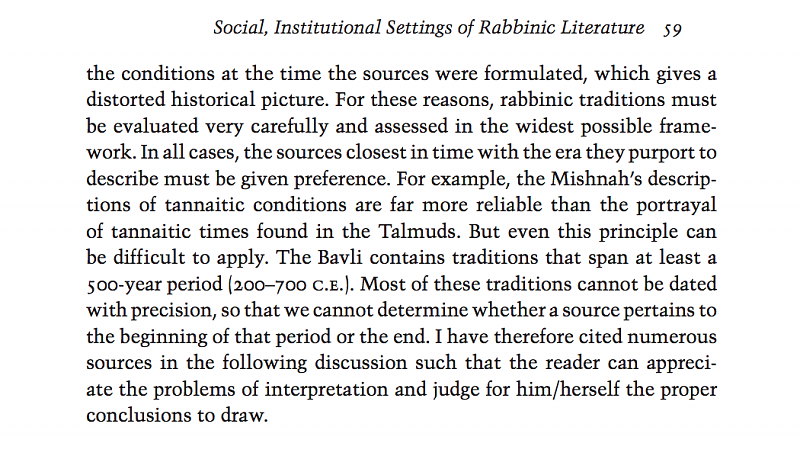
http://aveinu.homestead.com/The_Camb...literature.pdf
ثالثا :الجزم بالاقتباس باطل هنا نظرا لعدم توفر اي مخطوطة للتلمود اليوم يعود تاريخها لما قبل الاسلام .
نقرا في الموسوعة اليهودية JEWISH ENCYCLOPEDIA :
Earliest Manuscript of the Babli.
In the editions the Babylonian Talmud is so arranged that each paragraph of the Mishnah is followed by the portion of the Talmud which forms the commentary on it; the portions are frequently divided into sections, rubricked by the successive sentences of the mishnaic paragraph on which they are based, although an entire paragraph occasionally serves as a single text. Thus Babli on Ket. ii. 1 (16a-18b) is divided into six sections; but there is no division into sections for ii. 2 (18b-20b), ii. 3 (20b-22a), ii. 5 (23b), and ii. 9 (27b-28a). There are three sections for ii. 4 (23a); two for ii. 6 (23b-26a), ii. 7 (26b-27a), and ii. 8 (27a, b); and eight for ii. 10 (28a, b)
. In the Munich codex, which is based on a manuscript of the middle of the ninth century (see Lewy in "Breslauer Jahresbericht," 1905, p. 28)
, the text of the entire chapter of the Mishnah is written in large characters on the inner portion of the page, separated from the Talmudic text, which is in a different script. In the fragments in the Bodleian Library, Oxford, written in 1123 and containing a portion of the treatise Keritot (see "J. Q. R." ix. 145), each chapter is headed by the entire mishnaic text on which it is based
http://www.jewishencyclopedia.com/articles/14213-talmud
فاقدم مخطوطة للتلمود عندنا هي مخطوطة ميونخ و التي هي في الاصل نسخت من مخطوطة اخرى في منتصف القرن التاسع
وقد تم نسخ مخطوطة ميونخ في القرن الرابع عشر الميلادي
نقرا من FREDBERG JEWISH MANUSCRIPT SOCIETY:
Between the years 1342 and 1343 Shlomo ben Shimshon copied by hand the complete Babylonian Talmud in one volume containing 577 pages.
The type of script Shlomo ben Shimshon used was not the elegant square script commonly used for writing canonical treatises, but a middling script—that enabled a denser and more massive script and with which the copyist was able to include all 37 tractates of the Talmud in addition to the Mishna in a single volume. Apparently, Shlomo ben Shimshon’s achievement is unprecedented—not only for being the only volume of the Babylonian Talmud preserved in manuscript, but primarily for being the only one created from the outset as a single volume. Over the generations, the manuscript made its way across Europe, passing among various owners who left their signatures in the body of the manuscript. We do not know the name of its original owner since his name was erased by one of the manuscript’s later owners. Various hypotheses have been raised about its whereabouts in the intervening centuries, but what is certain is that some time during the nineteenth century this volume, along and other religious manuscripts, were collected from a German church and placed in the Munich State Library, hence its name—The Munich Manuscript.
http://web.nli.org.il/sites/nlis/en/...munich_95.aspx
رابعا : دعوى الاقتباس من يهود الجزيرة العربية مردودة هنا نظرا لاختلاف البيئة اليهودية في الجزيرة العربية عن تلك الموجودة خارج الجزيرة العربية من جهة الثقافة الدينية و الاجتماعية
فقد ذكر بعض النقاد ان يهود الجزيرة العربية تميزوا بعدة امور تفصلهم عن يهود الشام و العراق و مصر :
اولا : الانعزالية الاجتماعية و البعد الجغرافي عن بقية يهود العالم مما جعل يهود الجزيرة العربية شبه منقطعين عن بقية يهود العالم و لا يربطهم الا مسمى الديانة و رابطة الدم
ثانيا : ضحالة العلم الديني لدى يهود الجزيرة العربية مقارنة ببقية يهود العالم .
و مما يدل على هذا ما نقرؤه في كتاب تاريخ اليهود في بلاد العرب لاسرائيل ولفنسون الصفحة 11 -12:
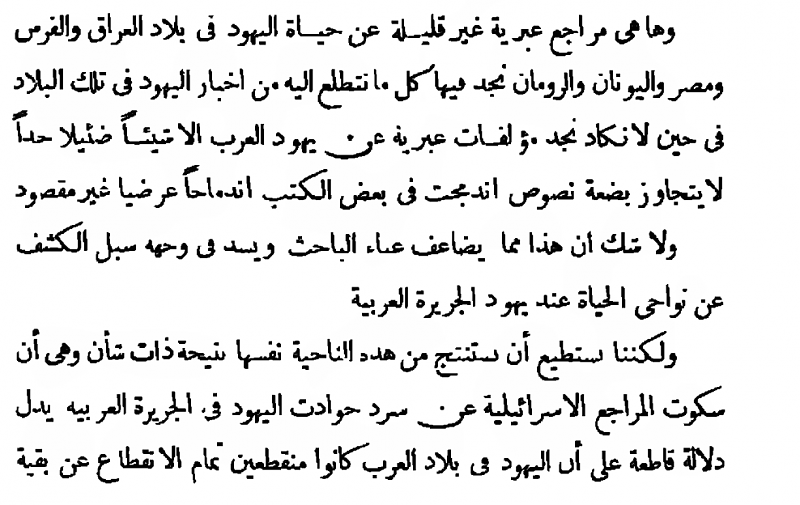
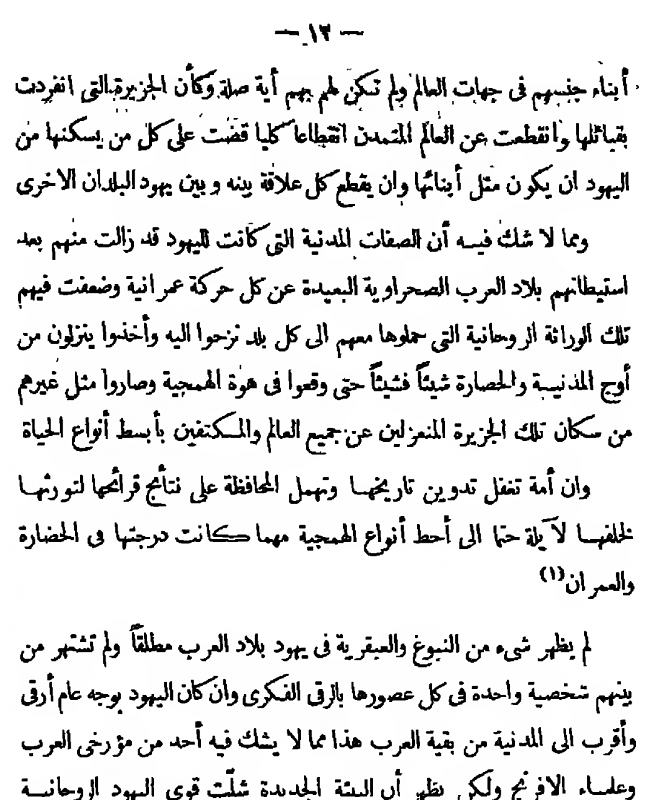
file:///Users/MacbookPro/Downloads/مكتبة نور - تاريخ اليهود في بلاد العرب في الجاهلية وصدر الإسلام.pdf
ويؤيد هذا ما تقوله الموسوعة اليهودية JEWISH ENCYCLOPEDIA عن احبار يهود المدينة (الذي في نظرهم كانوا مصدرا من مصادر القران حسب ادعائهم و حاش لله )
he connected his teaching with that of the Holy Scriptures of the Jews and Christians, of whose contents, however, he had in many particulars only a very imperfect knowledge—
his teachers having been monks or half-educated Jews
—and this knowledge he often repeated in a confused and perverted fashion.
http://www.jewishencyclopedia.com/articles/8263-islam
ثالثا : ذكر ان يهود الجزيرة العربية من ضحالة علمهم في نظر بقية اليهود لم يكونوا ينفذوا وصايا التلمود بل ان التلمود لم يكن مصدرا مهما لهم
نقرا من كتاب تاريخ اليهود في بلاد العرب لاسرائيل ولفنسون الصفحة 13
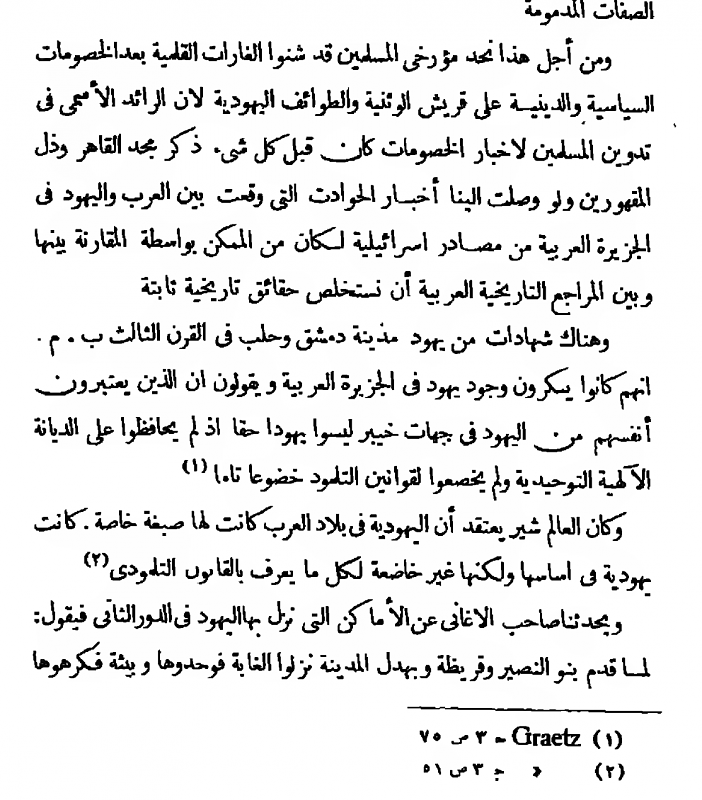
خامسا : امية النبي صلى الله عليه وسلم تسقط دعوى الاقتباس من اساسها فكيف لعربي امي لا يجيد القراءة و لا الكتابة بالعربية ان يقرا و يطالع كتابا يهوديا مكتوب بالعبرية او السريانية او الحبشية (كما سنوضح لاحقا ) !!!!! .
قال تعالى : ((
وَمَا كُنتَ تَتْلُو مِن قَبْلِهِ مِن كِتَابٍ وَلَا تَخُطُّهُ بِيَمِينِكَ ۖ إِذًا لَّارْتَابَ الْمُبْطِلُونَ
(48) بَلْ هُوَ آيَاتٌ بَيِّنَاتٌ فِي صُدُورِ الَّذِينَ أُوتُوا الْعِلْمَ ۚ وَمَا يَجْحَدُ بِآيَاتِنَا إِلَّا الظَّالِمُونَ (49)))
و نقرا في صحيح البخاري كتاب الصوم باب قول النبي صلى الله عليه وسلم لا نكتب ولا نحسب
1814 حدثنا آدم حدثنا شعبة حدثنا الأسود بن قيس حدثنا سعيد بن عمرو أنه سمع ابن عمر رضي الله عنهما عن النبي صلى الله عليه وسلم أنه قال
إنا أمة أمية لا نكتب
ولا نحسب الشهر هكذا وهكذا يعني مرة تسعة وعشرين ومرة ثلاثين
و نقرا في صحيح بن حبان كتاب السير باب الموادعة و المهادنة رقم الحديث: 4982
(حديث مرفوع) أَخْبَرَنَا النَّضْرُ بْنُ مُحَمَّدِ بْنِ الْمُبَارَكِ ، قَالَ : حَدَّثَنَا مُحَمَّدُ بْنُ عُثْمَانَ الْعِجْلِيُّ ، قَالَ : حَدَّثَنَا عُبَيْدُ اللَّهِ بْنُ مُوسَى ، عَنْ إِسْرَائِيلَ ، عَنْ أَبِي إِسْحَاقَ ، عَنِ الْبَرَاءِ ، قَالَ : " اعْتَمَرَ النَّبِيُّ صَلَّى اللَّهُ عَلَيْهِ وَسَلَّمَ فِي ذِي الْقَعْدَةِ ، فَأَبَى أَهْلُ مَكَّةَ أَنْ يَدَعُوهَ أَنْ يَدْخُلَ مَكَّةَ حَتَّى قَاضَاهُمْ عَلَى أَنْ يُقِيمَ بِهَا ثَلاثَةَ أَيَّامٍ ، فَلَمَّا كَتَبُوا الْكِتَابَ كَتَبُوا هَذَا مَا قَاضَى عَلَيْهِ مُحَمَّدٌ رَسُولُ اللَّهِ ، فَقَالُوا : لا نُقِرُّ بِهَذَا ، لَوْ نَعْلَمُ أَنَّكَ رَسُولُ اللَّهِ مَا مَنَعْنَاكَ شَيْئًا ، وَلَكِنْ أَنْتَ مُحَمَّدُ بْنُ عَبْدِ اللَّهِ ، فَقَالَ : أَنَا رَسُولُ اللَّهِ ، وَأَنَا مُحَمَّدُ بْنُ عَبْدِ اللَّهِ ، فَقَالَ لِعَلِيٍّ : امْحُ رَسُولَ اللَّهِ ، قَالَ : وَاللَّهِ لا أَمْحُوكَ أَبَدًا ، فَأَخَذَ رَسُولُ اللَّهِ صَلَّى اللَّهُ عَلَيْهِ وَسَلَّمَ الْكِتَابَ
وَلَيْسَ يُحْسِنُ يَكْتُبُ ، فَأَمَرَ
، فَكَتَبَ مَكَانَ رَسُولِ اللَّهِ مُحَمَّدًا ، فَكَتَبَ هَذَا مَا قَاضَى عَلَيْهِ مُحَمَّدُ بْنُ عَبْدِ اللَّهِ ، أَنْ لا يَدْخَلَ مَكَّةَ بِالسِّلاحِ إِلا السَّيْفَ ، وَلا يَخْرُجُ مِنْهَا بِأَحَدٍ يَتْبَعُهُ ، وَلا يَمْنَعُ أَحَدًا مِنْ أَصْحَابِهِ إِنْ أَرَادَ أَنْ يُقِيمَ بِهَا ، فَلَمَّا دَخَلَهَا وَمَضَى الأَجَلُ أَتَوْا عَلِيًّا
و نقرا في صحيح مسلم كتاب الجهاد و السير باب صلح الحديبية
1783 حدثنا إسحق بن إبراهيم الحنظلي وأحمد بن جناب المصيصي جميعا عن عيسى بن يونس واللفظ لإسحق أخبرنا عيسى بن يونس أخبرنا زكرياء عن أبي إسحق عن البراء قال لما أحصر النبي صلى الله عليه وسلم عند البيت صالحه أهل مكة على أن يدخلها فيقيم بها ثلاثا ولا يدخلها إلا بجلبان السلاح السيف وقرابه ولا يخرج بأحد معه من أهلها ولا يمنع أحدا يمكث بها ممن كان معه قال لعلي اكتب الشرط بيننا بسم الله الرحمن الرحيم هذا ما قاضى عليه محمد رسول الله فقال له المشركون لو نعلم أنك رسول الله تابعناك ولكن اكتب محمد بن عبد الله فأمر عليا أن يمحاها فقال علي لا والله لا أمحاها فقال رسول الله صلى الله عليه وسلم
أرني مكانها فأراه مكانها
فمحاها وكتب ابن عبد الله .
و نقرا في السنن الكبرى للبيهقي كتاب النكاح
12916 باب لم يكن له أن يتعلم شعرا ولا يكتب قال الله تعالى: ( وما علمناه الشعر وما ينبغي له )
وقال: ( فآمنوا بالله ورسوله النبي الأمي ) قال بعض أهل التفسير: الأمي: الذي لا يقرأ الكتاب ، ولا يخط بيمينه . وهذا قول مقاتل بن سليمان ، وغيره من أهل التفسير .
( وأخبرنا ) أبو حازم الحافظ ، أنبأ أبو بكر الإسماعيلي ، ثنا علي بن سراج المصري ، ثنا محمد بن عبد الرحمن ، ابن أخي حسين الجعفي ، ثنا أبو أسامة ، عن إدريس الأودي ، عن الحكم بن عتيبة ، عن مجاهد ، عن عبد الله بن عباس - رضي الله عنهما - في قوله - عز وجل: ( وما كنت تتلو من قبله من كتاب ولا تخطه بيمينك ) ، قال:
لم يكن رسول الله - صلى الله عليه وسلم - يقرأ ، ولا يكتب .
هذا مع الاخذ بعين الاعتبار ان التلمود ان كان متوفرا لدى يهود الجزيرة العربية (على عكس ما ذكره اسرائيل ولفنسون في النقطة الرابعة اعلاه) فانه لا يمكن الا ان يكون باللغة العبرية او السريانية او حتى الحبشية و ان كان احتمالا ضئيلا
نقرا من الموسوعة اليهودية JEWISH ENCYCLOPEDIA :
What he received from the Jews was mixed with haggadic elements current orally among Arabian Jews or existing in written form [—
probably preserved in Ethiopic translations of Hebrew pseudepigraphic writings
.—K.];
http://www.jewishencyclopedia.com/articles/8263-islam
سادسا : التلمود بحد ذاته لم يكن متوفرا الا لكبار احبار اليهود و الدارسين منهم و ليس للعوام منهم فكيف يمكن لامي عربي ان يصل الى التلمود و يقتبس منها :
نقرا من الموسوعة اليهودية :
it became an encyclopedia of Jewish faith and scholarship,
comprising whatsoever the greatest representatives of Judaism in Palestine and in Babylon had regarded as objects of study and investigation and of teaching and learning, during the three centuries which elapsed from the conclusion of the Mishnah to the completion of the Talmud itself
. When the Mishnah, with the many ancient traditions to which it had given rise since the latter centuries of the Second Temple, was incorporated into the Talmud as its text-book,
the Talmud became a record of the entire epoch which was represented by the Jewish schools of Palestine and Babylon, and which served as a stage of transition from the Biblical period to the later aspect of Judaism
. Although the Talmud is an academic product and may be characterized in the main
as a report (frequently with the accuracy of minutes) of the discussions of the schools, it also sheds a flood of light on the culture of the people outside the academies
. The interrelation between the schools and daily life, and the fact that neither teachers nor pupils stood aloof from that life, but took part in it as judges, instructors, and expounders of the Law, caused the Talmud to represent even non-scholastic affairs with an abundance of minute details, and made it an important source for the history of civilization. Since, moreover, the religious law of the Jews dealt with all the circumstances of life, the Talmud discusses the most varied branches of human knowledge—astronomy and medicine, mathematics and law, anatomy and botany—thus furnishing valuable data for the history of science also.
..... The Talmud has been made the subject or the starting-point of a large portion of this widely ramified literature, which has been the product of the intellectual activity induced by its study, and to which both scholars in the technical sense of the word and also a large number of the studious Jewish laity have contributed
. The same faculties which had been exercised in the composition of the Talmud were requisite also for the study of it;
the Talmud therefore had an exceedingly stimulating influence upon the intellectual powers of the Jewish people, which were then directed toward other departments of knowledge. It is a noteworthy fact that the study of the Talmud gradually
became a religious duty, and thus developed into an intellectual activity having no ulterior object in view. Consequently it formed a model of study for the sake of study.
http://www.jewishencyclopedia.com/articles/14213-talmud
نقرا من كتاب التلمود اصله و تسلسله و ادابه الصفحة الثامنة
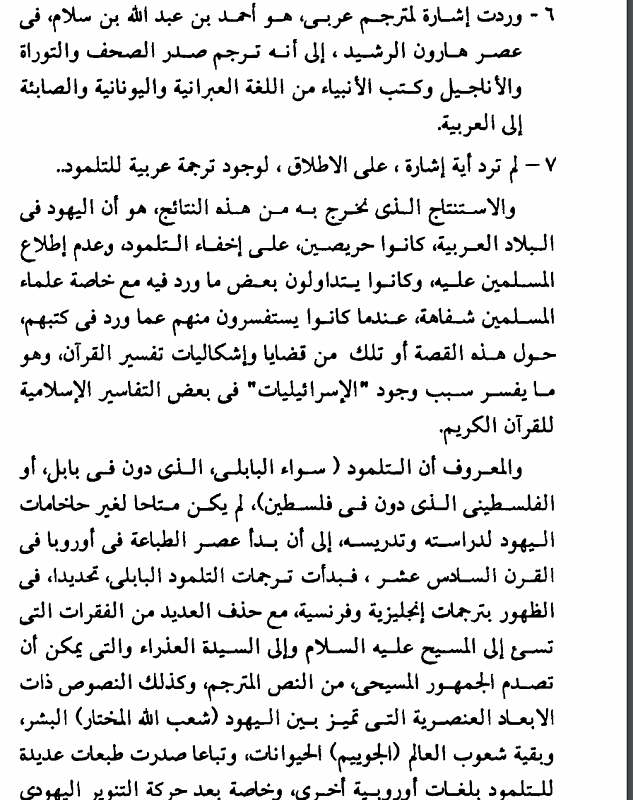
file:///Users/MacbookPro/Downloads/مكتبة نور - التلمود أصله وتسلسله وآدابه.pdf
نقرا في الشفا بتعريف حقوق المصطفى الجزء الاول :
(( فصل السابع : ا
لإخبار عن القرون السالفة الوجه الرابع : ما أنبأ به من أخبار القرون السالفة ، والأمم البائدة ، والشرائع الداثرة ، مما كان لا يعلم منه القصة الواحدة إلا الفذ من أحبار أهل الكتاب الذي قطع عمره في تعلم ذلك ، فيورده النبي - صلى الله عليه وسلم - على وجهه ، ويأتي به على نصه ، فيعترف العالم بذلك بصحته ، وصدقه ، وأن مثله لم ينله بتعليم .
وقد علموا أنه - صلى الله عليه وسلم - أمي لا يقرأ ، ولا يكتب ، ولا اشتغل بمدارسة ، ولا مثافنة ، ولم يغب عنهم ، ولا جهل حاله أحد منهم .
وقد كان أهل الكتاب كثيرا ما يسألونه - صلى الله عليه وسلم - عن هذا ، فينزل عليه من القرآن ما يتلو عليهم منه ذكرا ، كقصص الأنبياء مع قومهم
، وخبر موسى ، والخضر ، ويوسف ، وإخوته ، وأصحاب الكهف ، وذي القرنين ، ولقمان وابنه ، وأشباه ذلك من الأنباء ، وبدء الخلق ، وما في التوراة ، والإنجيل ، والزبور ، وصحف إبراهيم ، وموسى ، مما صدقه فيه العلماء بها ، ولم يقدروا على تكذيب ما ذكر منها ، بل أذعنوا لذلك ، فمن موفق آمن بما سبق له من خير ، ومن شقي معاند حاسد ، ومع هذا لم يحك عن واحد من النصارى ، واليهود على شدة عداوتهم له ، وحرصهم على تكذيبه ، وطول احتجاجه عليهم بما في كتبهم ، وتقريعهم بما انطوت عليه مصاحفهم ، وكثرة سؤالهم له - صلى الله عليه وسلم - ، وتعنيتهم إياه عن أخبار أنبيائهم ، وأسرار علومهم ، ومستودعات سيرهم ، وإعلامه لهم بمكتوم شرائعهم ، ومضمنات كتبهم ، مثل سؤالهم عن الروح ، وذي القرنين ، وأصحاب الكهف ، وعيسى ، وحكم الرجم ، وما حرم إسرائيل على نفسه ، وما حرم عليهم من الأنعام ، ومن طيبات أحلت لهم فحرمت عليهم ببغيهم . ))
سابعا: الاختلافات بين نص التلمود و نص الحديث الصحيح :
نص التلمود يتكلم مرة ان طول ادم عليه الصلاة و السلام كان يغطي السماوات بحيث تكون قدماه على الارض و راسه في اعلى السماوات بينما نص الحديث يذكر ان طول ادم عليه الصلاة و السلام كان ستون ذراعا
نص التلمود يذكر ان نقصان طول ادم عليه الصلاة و السلام كان عقوبة من الله عز وجل بسبب خطية ادم عليه الصلاة و السلام و اما الحديث فليس فيه ذكر للخطية اصلا
.
ملاحظة :
روي في مصنف عبد الرزاق كتاب المناسك باب بنيان الكعبة
9090 عبد الرزاق ، عن هشام بن حسان قال : حدثني سوار ، عن عطاء بن أبي رباح قال : " لما أهبط الله آدم كان رجلاه في الأرض ورأسه في السماء ، يسمع كلام أهل السماء ودعاءهم ، فأنس إليهم ، فهابت الملائكة منه حتى شكت إلى الله في دعائها وفي صلاتها فأخفضه الله إلى الأرض ، فلما فقد ما كان يسمع منهم استوحش ، حتى شكى إلى الله في دعائه وفي صلاته ، فوجهه إلى مكة ، فكان موضع قدمه قرية ، وخطوته مفازة حتى انتهى إلى مكة ، وأنزل الله ياقوتة من ياقوت الجنة ، فكانت على موضع البيت الآن ، فلم يزل يطاف به حتى أنزل الله الطوفان فرفعت تلك الياقوتة ، فبعث الله إبراهيم فبناه ، فذلك قول الله عز وجل : وإذ بوأنا لإبراهيم مكان البيت .
و للرد : نقول ان هذه الرواية موقوفة على عطاء بن ابي رباح و ليست مرفوعة للنبي صلى الله عليه وسلم و كل ما هو ليس من الكتاب او السنة الصحيحة او عليها اجماعا من قبل اهل العلم فهي قابلة للاخذ و للرد
وقد رد الامام الامام بن كثير رحمه الله هذا التفسير المروي من عطاء في البداية و النهاية الجزء الاول باب ما ورد في خلق ادم عليه السلام:
((وقد روى عبد الرزاق ، عن هشام بن حسان ، عن سوار خبر عطاء بن أبي رباح ، أنه كان لما أهبط ، رجلاه في الأرض ورأسه في السماء فحطه الله إلى ستين ذراعا . وقد روي عن ابن عباس نحوه . و
في هذا نظر ; لما تقدم من الحديث المتفق على صحته عن أبي هريرة أن رسول الله صلى الله عليه وسلم قال : إن الله خلق آدم وطوله ستون ذراعا ، فلم يزل الخلق ينقص حتى الآن ، وهذا يقتضي أنه خلق كذلك لا أطول من ستين ذراعا
، وأن ذريته لم يزالوا يتناقص خلقهم حتى الآن . ))










 رد مع اقتباس
رد مع اقتباس


المفضلات